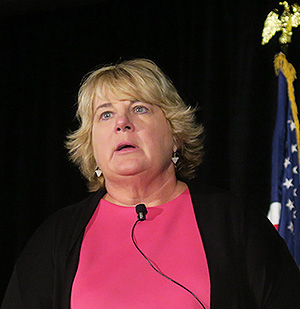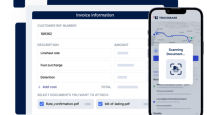Staff Reporter
NAFC Panels: Data Is Used to Cut Repair Costs, Improve Policy

[Stay on top of transportation news: Get TTNews in your inbox.]
INDIANAPOLIS — Why does an average truckload fleet’s trucks go 8,400 miles before a breakdown but the “best-in-class” fleet goes 44,600 before one?
That was a question Jim Buell, executive vice president of sales at FleetNet America Inc., asked the audience at the National Accounting and Finance Council’s 2019 annual conference.
The answer, it seems, is simple, Buell said. It’s not about luck. It’s all about data. And data was a hot topic at the NAFC conference.

Chris Spear by Jim Stinson/Transport Topics
Also at NAFC
“The difference is some fleets are making use of data and some are not,” said Buell, who declined to identify the fleets in the research he showed the June 10 gathering of trucking firm officials here.
Repair and maintenance are 18% of vehicle costs, the fourth-largest expense for trucking firms, he said. But some firms spend more than other firms, and the firms spending more likely do not need to, he said.
Buell said roadside repairs now are costing four times what regular repairs cost, and that expense has gone up 15% in the nine months ending March 31, Buell said.
The reason is, there is a shortage of technical and maintenance workers in the trucking industry, Buell said.
“I would expect this trend to possibly continue,” he said. “There is a tech shortage out there, and basic economics tell you that when there is a shortage of labor, costs will go up.”
The key to keeping costs down is using data to predict when parts will fail, Buell said. It’s understandable that tires burst when they run over nails, he said, but many fleets see parts fail simply because they were not maintained or replaced on time.
Buell found his truckload “best-in-class” fleet went extraordinarily long intervals in average times between some repairs or replacements.
One thing the best firms did was prepare for seasonal challenges, such as cold weather. The other thing he noticed in his research of truckload firms is that the “best in class” didn’t excel in all fields of repair and maintenance. They have room to improve in other areas, he told the audience, and because they use data, they are up to the challenge.
#InCaseYouMissedIt Rebecca Brewster's talk yesterday showed just how important it is to benchmark operational cost, take the ops cost survey now #NAFC19 https://t.co/Ch5ANhNfwA https://t.co/lxIZWjrIWX — NAFC Trucking (@NAFC_ATA) June 11, 2019
Some truckload firms would save about $51,000 in a quarter by just getting to average performance in maintenance and repair, Buell said.

In our third episode of RoadSigns, Season Three, we ask: Is Predictive Maintenance the Next Big Leap for Fleet Efficiency? Hear a snippet from host Seth Clevenger, above, and get the full program by going to RoadSigns.TTNews.com.
But not all costs are normal, said Daniel Kanabroski, an information technology specialist at Centrality Business Technologies of Louisville, Ky.
There are growing cyberthreats from hackers, and trial lawyers now are targeting trucking firms like never before, he said.
“I drove up here from Louisville today and I saw, I think, 3,000 signs for law firms that want to sue you all,” Kanabroski said. “It’s a big issue … because it’s a profit center. That’s a risk you guys have on an ongoing basis.”
But it is perhaps hackers who present the greatest threats to private firms. There is a growing threat to trucking companies posed by “ransomware,” a virus that locks up computer systems until a hacker’s demands are met. Centrality, an IT company, has found bad numbers for trucking firms that get compromised.
“Ninety percent of trucking companies … that get their data ‘ransomwared,’ or it gets compromised, are out of business within six months,” Kanabroski said.
But the industry needs even more data.

Rebecca Brewster by Jim Stinson/Transport Topics
Speaking at a separate session June 10, American Transportation Research Institute President Rebecca Brewster urged trucking firms to sign up for ATRI’s data gathering. The data can be given to ATRI to better study trucking, and the numbers can be kept confidential, she said.
ATRI founded its operational-cost research in 2008 after it became clear the public sector was not well-informed about what it cost to operate a truck. Bad data, Brewster said, could affect policy.
“There were wildly divergent estimates of what it cost to operate a truck,” Brewster said. “Anywhere from $22 an hour … to over $300 per hour. For the most part, those estimates or studies were modeling data and not using real-world data.”
ATRI annually calculates a cost per mile and a cost per hour for truck operation. The costs are broken down by regions and industry segments, such as truckload, less-than-truckload and “other.”
The research organization also collects real-time data in almost 1 million trucks in the United States, allowing it to look at traffic patterns, parking problems and frequency of truck idling.
Brewster said the capability allows ATRI to calculate lost productivity caused by traffic congestion. The 2016 numbers were sizable, as Brewster said congestion caused the equivalent of 425,000 truck drivers sitting idle — for a whole year. Brewster said the industry’s financial cost, caused by that congestion, was $74.5 billion in 2016.




